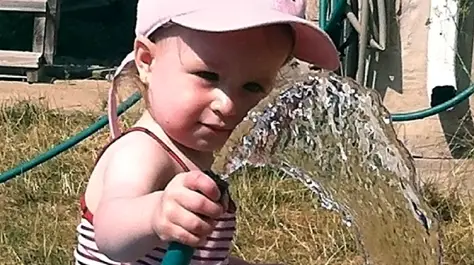Water fascinates young children. Whether the water is in small or large quantities, it’s always important to think about safety when water is involved and to be sure that young children are properly supervised. With this in mind, let’s talk about water play!
A small bin full of water placed on a table can provide young children with hours of learning. I found that when my class of four-year-olds was involved in water-play experiences, there was no such thing as a limited attention span!
Creating this kind of experience is a simple three-step process:
- Provide objects for your child to use to explore with, like these:
- plastic measuring cups that float
- ceramic cups of similar sizes that do not float (non-fragile)
- tubes
- small PVC pipes
- sieves
- boats
- plastic bottles
- measuring spoons
- feathers
- rocks
- funnels
- small plastic toys
- wooden blocks
- an old-fashioned hand mixer
- Join in the fun:
- Fill up and pour out the containers.
- Use the measurement lines on the measuring cups to help teach words and develop language, such as: full, empty, half-full, 1 cup, and 2 cups.
- Compare objects that float with those that sink.
- Talk about what you and your child are observing, as in these examples:
- Since water is a liquid, it changes shape to fit whatever container it’s in.
- Some things float on water, and some things sink.
- The way an object is shaped can help determine whether it floats or sinks.
Sometimes, step 3 is difficult to do in the midst of the activity, because your child can become so engrossed that he or she doesn’t have time for you! That’s a good thing, so in my classroom, I would take a few pictures of the children as they played; then I showed them the pictures afterward and posed questions about what they were doing or what they observed. Having a discussion like this will help your child construct understandings and learn to describe ideas, including liquid, density, buoyancy, measurement, matter, and weight—all of which are physical science concepts that he or she will need to understand in later grades. Your child won’t necessarily be able to use or understand these words yet; but through exploration, he or she will have gained experience with the concepts that the words stand for.

Of course, these days, you don’t have to limit yourself to still pictures—you can capture and present short videos that illustrate the things you want your child to observe and discuss. You also don’t have to do this activity with a bin or water on a table; it can be perfect during bathtime, followed by a conversation at bedtime.
As with many science topics, there are some wonderful children’s books about water; one of my favorites is Water’s Way by Lisa Westberg Peters. Share this book with your child to help develop his or her understanding about evaporation, condensation, erosion, and how water flows—through text and pictures designed for a young child’s reading level.
Here are some more ideas for water explorations:
- Place a small amount of water in a plastic bowl. Give your child a thick paintbrush and tell him or her to “paint” with water on the sidewalk or at the park or on the concrete slab in your backyard. Talk about the “disappearing” pictures or letters, which can be a wonderful introduction to a discussion about evaporation!
- Buy an eggbeater or hand mixer at the dollar store. Have your child play with bubbles not just by blowing bubbles, but also by placing dish detergent in a large bin and using the beater to make lots and lots of bubbles. This will also provide hand coordination practice for your child!
- Place ice cubes on a napkin, and have your child watch the ice melt. Have him or her hold the cube for a minute or so, and discuss how his or her warm hand makes the ice melt faster.
- During bathtime, talk about sponges and how they absorb water. Compare and contrast the sponge with a bar of soap, which does not absorb water. Compare whether both can float. Try floating and sinking other objects. Ask questions about why your child thinks this happens and how weight and shape can make a difference.
Remember, you don’t have to be a science teacher to teach concepts like these to your child. All you have to do is create an environment with interesting things to explore and objects to explore with. Put your child in the environment, and become curious and interested in what he or she sees, hears, and touches, and explore right along with him or her. As you do this, you will be planting seeds of understanding about physical science concepts that your child will formally encounter in school before too long.

